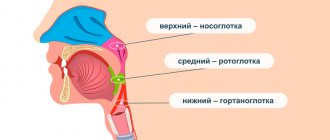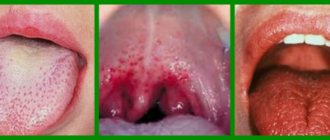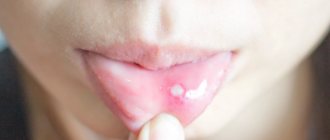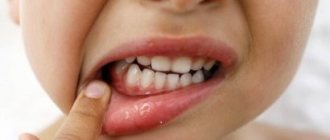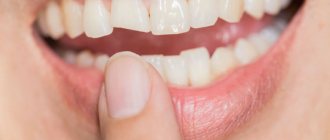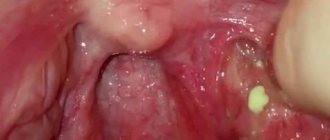Herpangina is one of the most common viral diseases in children. Almost everyone experiences this disease in childhood, although this diagnosis also occurs in adults. From a scientific point of view, the very name “herpetic sore throat” was incorrectly given to the disease. Previously, the disease was little studied. Scientists, noticing the similarity of rashes during the disease with those of herpes, came to the conclusion that the causative agent of the disease was the herpes virus, and gave the disease a name that has stuck and is found in the medical literature in exactly this form. Although the disease has nothing in common with herpes infection. It has been established that the cause of herpetic sore throat is enteroviruses - Coxsackie viruses of groups A and B and ECHO viruses (echoviruses). In medical reference books you can find different versions of the names of this disease: aphthous tonsillitis, vesicular pharyngitis, herpetic tonsillitis, herpangina, etc.
As already mentioned, children under ten years of age are at risk: infants, preschoolers and children of primary school age. The severity of the disease depends on the age of the child. The disease is most severe in children in the first year of life. Preschoolers are more often infected because at this age they do not pay due attention to hygiene, have contact with animals and are often in children's groups. To become infected, it is enough to eat unwashed fruit. This should also include the immaturity of immunity at an early age. The disease is highly contagious, and often its outbreaks become epidemic. It is noteworthy that this disease does not occur in babies in the first months of life - the antibodies found in mother's milk create some kind of immunity to herpangina.
One can trace the obvious seasonality of herpetic sore throat: the peak occurs in summer and autumn. As a rule, having been ill once, a child becomes immune to re-infection, so this disease is less common among adolescents and adults.
Infection can occur in one of three ways:
- airborne
- contact
- fecal-oral.
With the airborne method, infection occurs by sneezing, coughing, or talking with a carrier of the virus. In case of contact - through discharge from the nasopharynx. With the fecal-oral method - through dirty hands, through unwashed food, toys and pacifiers, which is especially typical for children.
Even a recovering person can still spread the infection around him for about a month, so it is believed that herpes sore throat is highly contagious: a child can easily become infected in kindergarten from a baby who does not even have obvious symptoms of the disease. If one family member gets sick, most likely everyone will suffer from the disease.
How does infection spread throughout the body? First, the virus from the nasopharynx reaches the intestinal lymph nodes through the lymph flow. Already in the intestines, the virus gains strength and enters the blood, and severe inflammation begins in the oropharynx.
What causes red dots in the sky?
Experts identify several factors that contribute to the appearance of red dots on the palate in a child or adult:
- Pathological processes in the circulatory system and vessels.
- Infectious diseases.
- Allergic reaction.
- Rare diseases.
Based on the causes and individual characteristics of the body, a red rash can appear either once in a lifetime or quite often. If spots appear repeatedly, then we can talk about herpes viruses, thrush or enteroviral infections.
When exposed to infection, in addition to red dots on the palate, the child’s temperature rises, pain in the throat and larynx appears, weakness, and it becomes painful to swallow. The rash affects not only the palate, but also the tongue, as well as the inside of the cheeks. Infections that cause a rash include:
- Flu.
- Roseola.
- Scarlet fever.
- Meningitis.
- Typhus.
- Rubella.
- Staphylococcal infections.
- Chickenpox.
- Mononucleosis.
- Erythema.
- Syphilis.
Children suffer from chickenpox, rubella and scarlet fever in a milder form than adults, receiving immunity for life. In adults, these diseases occur with complications. But coping with herpes sore throat and stomatitis is much more difficult for children. These diseases progress quickly and greatly worsen the child’s condition.
Probable Causes
Red spots in the throat are the main sign of the occurrence of pathological processes in the mucous membrane of the airways. The following factors can trigger their development:
- dry air;
- inhalation of volatile chemicals;
- hypothermia;
- vitamin deficiency;
- allergic reactions;
- decreased body reactivity;
- infectious diseases;
- disruptions in the gastrointestinal tract;
- endocrine disorders;
- bad habits.
The cause of the appearance of red spots on the throat and palate can be identified by their location, number and accompanying manifestations.
Most often, the causes of the occurrence lie in the development of bacterial and viral infections. However, in order to make sure that such suspicions are correct, you need to seek help from a doctor.
Herpetic stomatitis
With stomatitis, spots in the throat range from light pink to red. Areas with the rash may merge or be located far from each other. There are several types of stomatitis, among which herpetic stomatitis is especially common.
This disease is accompanied by headache, high fever, and red dots form on the upper palate, tongue, lips, and cheeks. These points turn into bubbles and explode to form red erosions. The herpes virus remains in the body for life. With strong immunity, it is in an inactive phase, and will manifest itself in the following cases:
- With exacerbation of chronic inflammatory processes.
- After a course of corticosteroids.
- In case of trauma to the mucous membrane.
- During emotional turmoil, allergies, vitamin deficiency.
- When the immune system is weakened.
Treatment of herpetic stomatitis should be prescribed by a qualified dentist.
Diagnosis of red spots on the palate of a child
The doctor makes a diagnosis taking into account the visible symptoms, the baby’s complaints, and research data.
When identifying points in the child’s oral cavity, it is necessary to find out the recommendations of a specialist. He will be able to determine whether this sign indicates the presence of a pathological process in the mouth. In addition, he can refer you to specialized doctors for a more accurate diagnosis. Possible diagnostic measures are a smear for bacterial culture, a general blood test, allergy tests, and stool analysis.
Angina
Herpetic sore throat is also a fairly common cause of the formation of red dots in the throat on the roof of the mouth. The disease is characterized by high fever that lasts for several days, pain when swallowing, discomfort in the abdomen, and enlarged lymph nodes.
Streptococcal sore throat is accompanied by general malaise, headache, and high body temperature. The tonsils become loose and covered with plaque. In this case, antibiotic therapy is used, but the treatment regimen must be drawn up by a qualified specialist.
Treatment methods
If you notice a reddish rash in the oral cavity that looks like numerous pimples, you need to find out the doctor’s recommendations. Self-medication of such growths in the mouth is prohibited, since in everyday conditions it is difficult to identify the provoking factor of irritation of the mucous membrane.
General therapy
After diagnosis, which is aimed at detecting pathogenic microorganisms, the specialist prescribes medications that can eliminate the pathological process in the palate.
In many situations the following drugs are used :
- Antibiotics . The doctor prescribes antibiotics in tablets or as injections.
- Antiviral drugs . Such medications are used in situations where a red rash on the palate was caused by a herpes virus. The child is prescribed Zovirax, Valtrex, Acyclovir or Famvir. The choice of drug is made by the doctor, based on the condition of the oral cavity.
- Antihistamines . The specialist prescribes medications such as Suprastin, Aleron, Ketotifen. They are taken in tablet form or administered intramuscularly.
Zovirax
Valtrex
Acyclovir
Famvir
Suprastin
Aleron
Ketotifen
Treatment of the rash on the palate is extremely important, since in its absence, swelling of the mucous membrane is likely to occur with further spread to the larynx.
Local therapy
Taking into account the diagnosis, the doctor prescribes therapy. For viral infections of the oral cavity, antibiotics are prescribed; for the treatment of herpes, antiviral drugs are prescribed. When a fungus is detected, antibacterial medications are used.
In addition, the specialist can prescribe local therapy, which helps eliminate red spots on the palate.
Such means include:
Miramistin
Kamistad
Holisal
Metrogil Denta
Solcoseryl
Any remedy should be used after consultation with a doctor.
Traditional methods
It is possible to eliminate unpleasant symptoms through traditional therapy.
It should be borne in mind that treatment without appropriate diagnosis can worsen the situation, therefore it can only be of an auxiliary nature. Rinsing helps remove stains :
- 0.5 tsp. soda and salt, a few drops of iodine per 1 tbsp. water;
- 2 tbsp. l. chamomile is poured into 0.2 liters of boiled water and infused for half an hour, then filtered and diluted to the initial amount;
- propolis infusion, which is diluted with water in a ratio of 1 to 20.
Important! Therapy must be previously agreed with a specialist.
Other reasons for finding red dots in the sky
Red dots on the upper palate may be the result of the following rare diseases:
Pyogenic granuloma
Occurs in a place often subject to trauma. It is necessary to excise the tumors at the root, after which electrocoagulation therapy is prescribed.
Kaposi's sarcoma
It is a malignant neoplasm with a purple hue. Local chemotherapy is prescribed, and measures are taken to increase the patient’s immunity.
Pathechia in the sky
These are small flat spots that often appear during mononucleosis. May be a manifestation of smallpox, thrombocytopenia, typhoid fever and endocarditis.
If a red rash occurs in the mouth, you do not need to make a diagnosis and prescribe treatment yourself.
It is necessary to consult with a specialist, find out the cause of the spots and receive appropriate treatment. The DentalGuru dental clinic employs experienced and professional dentists who guarantee painless and effective treatment of stomatitis and other dental diseases. This article is for informational purposes only, please consult your doctor for details!
Other reasons
Rashes in the throat, if severe discomfort and pain occur, can signal a change in the morphological properties of soft tissues in the areas of their localization. Erythematous spots, which are localized on the soft palate, in some cases develop due to the occurrence of complex diseases:
- exudative erythema;
- staphylococcal infection;
- syphilis;
- Kawasaki syndrome;
- roseola;
- meningitis;
- typhus
Since the list of possible pathologies is very extensive, if red spots appear in the throat, a visit to the therapist cannot be postponed. The principles of therapy depend on the etiological causes of the development of the disease, the localization of pathological formations and accompanying clinical symptoms. As a rule, in order to eliminate infectious ENT diseases, antiviral and antibacterial drugs are used. Analgesics, antipyretics and antihistamines can also make the patient feel better and eliminate discomfort.
Some bacterial and viral infections cause rashes and spots on the mucous membrane of the throat. They are most often red in color, but can be of different sizes and shapes, and their localization also differs. They can be located in different places.
In some pathologies, red spots in the throat occur only in rare cases and are not important for diagnosis. They do not affect subsequent therapy of the underlying disease. Similar diseases include influenza and ARVI, in which red spots in the throat do not always appear and not in all patients.
However, there are situations when a doctor, looking at a rash in the throat, can make a diagnosis immediately, since in some cases characteristic spots become one of the main symptoms. Such pathologies include, for example, acute stomatitis and herpetic sore throat. It is very unpleasant to notice such a rash in the mouth, especially if red spots are found in the throat of a small child.
Possible complications
In the absence of appropriate treatment for a red rash that has formed on the palate, changes in the cellular structure and epithelial tissue are likely.
This can cause the red rash to increase in size and trigger the development of the following diseases :
- Pyogenic granuloma. It is characterized by thickening of blood vessels with disruption of their blood flow. The dots in the sky will change their usual reddish hue to blue. They will interfere with conversation and eating. In the future, they can cause malignancy and can cause death.
- Petechiae of the palate. The last stage of hardening of reddish spots on the sky, when the baby was not helped. It is characteristic of pathology that new ones can form near previous formations. In many situations, such adverse effects are provoked by a rash associated with herpes virus or mononucleosis.
- Kaposi's sarcoma. A red rash of viral origin that is not eliminated in a timely manner can transform into flat growths of bright red color. This pathology, characteristic of children with weak immunity or infected with HIV, is a complex disease with an extremely high mortality rate.
Pyogenic granuloma
Petechiae of the palate
Kaposi's sarcoma
It is possible to eliminate such complications with timely treatment of emerging diseases.
Video about clinical observation of Kaposi's sarcoma:
Allergic spots
If the cause is an allergy, the doctor will prescribe antihistamines.
Red spots on the palate, which are not accompanied by symptoms of intoxication and a sharp drop in body temperature, may indicate an allergic reaction of the body. Among the main irritants that provoke changes in the color of the tissues of the oral mucosa are the following:
- taking medications;
- installation of a filling made of composite materials or a crown made of polymers;
- products;
- dental pins, prosthetic structures;
- products used for oral hygiene.
You should also not exclude typical allergens: animal hair, flowering plants, detergents based on chemical compounds used for household needs.
You can neutralize the effect of irritants with the help of antihistamines. They are selected individually, taking into account the type of allergen and the state of the immune system. Pharmacological agents that have an antihistamine effect are systemic and local. The success of treatment depends on the speed of elimination of the pathogen.
Red spots in the mouth during poisoning appear as a result of capillary paresis. The classic variant is a meningitis rash. It is recognized by the following sign: when pressed, the spots turn sharply pale, the color gains intensity as the impact weakens.
Rare diseases
Sometimes, behind red spots in the oral cavity lies the symptoms of rare, but quite dangerous diseases. The success of their treatment directly depends on early diagnosis and timely drug treatment, which minimizes the development of serious complications.
| Rare diseases | |
| Name | Description |
| Pyogenic granuloma | Dome-shaped erythematous nodular fragments form on the oral mucosa. Red spots often open and bleed, the process is accompanied by burning and pain. |
| Petechiae | An erythematous rash appears in the oral cavity, which occurs against the background of infectious mononucleosis. |
| Kaposi's sarcoma | It is characterized by the appearance of a non-inflammatory rash on the oral mucosa, provoked by the development of oncology. Later, the affected area spreads to the skin and lymph nodes. |
Often, red spots on the roof of the mouth signal simple problems; rare diseases are diagnosed in only 5% of cases. However, this is not a reason to postpone going to the clinic, because the insidiousness of such diseases lies in the intensive progression and development of complications, ending in suffocation against the background of swelling of the larynx.
